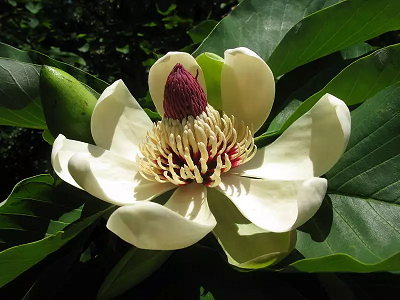Order: Magnoliales
Family: Magnoliaceae
General Overview: Magnolia obovata is a species of flowering tree in the Magnoliaceae family, commonly known as the Japanese bigleaf magnolia. It is native to Japan and can be found growing in the understory of deciduous forests.
Morphological Features: A deciduous tree of medium size, ranging from 15 to 30 meters in height, characterized by slate grey bark, this species features large leaves measuring 16–38 cm (occasionally up to 50 cm) in length and 9–20 cm (rarely 25 cm) in width. The leathery leaves are green on the upper surface, while the lower surface exhibits a silvery or greyish pubescence, terminating in an acute apex. Arranged in whorls of five to eight at the end of each shoot, the leaves contribute to the tree's distinct appearance. The sizable, cup-shaped flowers, measuring 15–20 cm in diameter, display 9-12 creamy, fleshy tepals and red stamens. Emitting a strong scent, these flowers bloom in early summer following the expansion of the leaves. The fruit takes the form of an oblong-cylindric aggregate of follicles, reaching lengths of 12–20 cm and widths of 6 cm, presenting a bright pinkish-red hue. Each follicle contains one or two black seeds enveloped in a fleshy orange-red coating.
Biological Characteristics: In traditional medicine, various parts of the Magnolia obovata tree have been used to treat a variety of ailments, such as anxiety, digestive problems, and respiratory infections. The bark of the tree contains compounds with anti-inflammatory and anti-tumor properties. Magnolia obovata is also highly valued as an ornamental tree, with its large leaves and showy flowers making it a popular choice for gardens and parks. Its wood is used for furniture and decorative items. Overall, Magnolia obovata is a versatile tree with a range of traditional and modern uses. Its cultural significance and aesthetic value make it an important species in horticulture and forestry.

